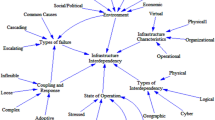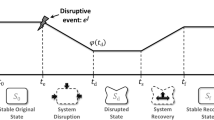Abstract
The interdependent network can be applied to model two or more infrastructure systems with mutual reliance. The failure of elements in one system may lead to failure of dependent elements in other systems, and this may happen recursively leading to a cascade of failures. In this paper, integer programming models are proposed to identify the most vulnerable network elements (nodes and edges), whose removal can maximally destroy the interdependent network, with minimum functional components survived after the cascading failure process. Numerical experiments are performed on several interdependent networks consisting of power grid and control communication network, to validate the proposed models and to identify the vulnerable network elements.








Similar content being viewed by others
References
Sforna, M., Delfanti, M.: Overview of the events and causes of the 2003 Italian blackout. Power Syst. Conf. Expos. 2006, 301–308 (2007)
Buldyrev, S., Parshani, R., Paul, G., Stanley, H., Havlin, S.: Catastrophic cascade of failures in interdependent networks. Nature 464, 1025–1028 (2010)
Stokes-Draut, J., Taptich, M., Kavvada, O., Horvath, A.: Evaluating the electricity intensity of evolving water supply mixes: the case of California’s water network. Environ. Res. Lett. 12, 114005 (2017)
Zhang, Y., Yang, N., Lall, U.: Modeling and simulation of the vulnerability of interdependent power-water infrastructure networks to cascading failures. J. Syst. Sci. Syst. Eng. 25(1), 102–118 (2016)
Parshani, R., Rozenblat, C., Ietri, D., Ducruet, C., Havlin, S.: Inter-similarity between coupled networks. Europhys. Lett. 92, 68002–68006 (2010)
U.S. Department of Transportation: An objectives- and performance-based approach for improving the design, operations, and maintenance of traffic signal systems. Traffic Signal Management Plans (2015)
Yang, Y., Motter, A.: Cascading failures as continuous phase–space transitions. Phys. Rev. Lett. 119, 248302 (2017)
Duenas-Osorio, L., Vemuru, S.: Cascading failures in complex infrastructure systems. Struct. Saf. 31(2), 157–167 (2009)
Wang, Z., Scaglione, A., Thomas, R.: Electrical centrality measures for electric power grid vulnerability analysis. In: The 49th IEEE Conference on Decision and Control, pp. 5792–5797 (2010)
Jenelius, E., Petersen, T., Mattsson, L.: Importance and exposure in road network vulnerability analysis. Transp. Res. A Policy Pract. 40(7), 537–560 (2005)
Abedin, M., Nessa, S., Al-Shaer, E., Khan, L.: Vulnerability analysis for evaluating quality of protection of security policies. In: The 2nd ACM Workshop on Quality of Protection, pp. 49–52 (2006)
Wang, S., Hong, L., Ouyang, M., Zhang, J., Chen, X.: Vulnerability analysis of interdependent infrastructure systems under edge attack strategies. Saf. Sci. 51(1), 328–337 (2013)
Sen, A., Mazumder, A., Banerjee, J., Das, A., Compton, R.: Identification of k most vulnerable nodes in multi-layered using a new model of interdependency. In: IEEE Conference on Computer Communications Workshops, pp. 831–836 (2014)
Nguyen, D., Shen, Y., Thai, M.: Detecting critical nodes in interdependent power networks for vulnerability assessment. IEEE Trans. Smart Grid 4(1), 151–158 (2013)
Li, Y., Ma, D., Zhang, H., Sun, Q.: Critical node identification of power systems based on controllability of complex networks. Appl. Sci. 5(3), 622–636 (2015)
Veremyev, A., Boginski, V., Pasiliao, E.: Exact identification of critical nodes in sparse networks via new compact formulations. Optim. Lett. 8(4), 1245–1259 (2014)
Veremyev, A., Sorokin, A., Boginski, V., Pasiliao, E.L.: Minimum vertex cover problem for coupled interdependent networks with cascading failures. Eur. J. Oper. Res. 232(3), 499–511 (2014)
Nguyen, H., Sharkey, T.: A computational approach to determine damage in infrastructure networks from outage reports. Optim. Lett. 11(4), 753–770 (2017)
Zhang, J., Modiano, E.: Connectivity in interdependent networks. arXiv:1709.03034 (2017)
Yu, Z., Huang, S., Ma, Z., Chen, G.: Identification of critical lines in power grid based on electric betweenness entropy. In: The 2015 IEEE PES Asia-Pacific Power and Energy Engineering Conference (2016)
Sun, X., Zhang, T., Zhang, B.: Identification of critical lines in power grid based on active power flow betweenness. In: The 5th International Conference on Electric Utility Deregulation and Restructuring and Power Technologies, pp. 1283–1287 (2016)
Liu, M., Zhao, L., Huang, L., Zhang, X., Deng, C., Long, Z.: Identification of critical lines in power system based on optimal load shedding. Energy Power Eng. 9, 261–269 (2017)
Qiang, Q., Nagurney, A.: A unified network performance measure with importance identification and the ranking of network components. Optim. Lett. 2(1), 127–142 (2008)
Gao, J., Buldyrev, S.V., Stanley, H., Havlin, S.: Networks formed from interdependent networks. Nat. Phys. 8, 40–48 (2012)
Parandehgheibi, M., Modiano, E., Hay, D.: Mitigating cascading failures in interdependent power grids and communication networks. In: 2014 IEEE International Conference on Smart Grid Communications, pp. 242–247 (2014)
Parandehgheibi, M., Modiano, E.: Robustness of interdependent networks: the case of communication networks and the power grid. In: IEEE Global Communications Conference, pp. 2164–2169 (2013)
Buldyrev, S., Shere, N., Cwilich, G.: Interdependent networks with identical degree of mutually dependent nodes. Phys. Rev. Lett. 83, 016112 (2011)
Bianconi, G., Dorogovtsev, S., Mendes, J.: Mutually connected component of networks of networks with replica nodes. Phys. Rev. Lett. 91, 012804 (2015)
Hwang, S., Choi, S., Lee, D., Kahng, B.: Efficient algorithm to compute mutually connected components in interdependent networks. Phys. Rev. Lett. 91, 022814 (2015)
Fan, N., Watson, J.: On integer programming models for the multi-channel PMU placement problem and their solution. Energy Syst. 6(1), 1–19 (2015)
Huang, Z., Zheng, Q.P., Pasiliao, E.L., Simmons, D.: Exact algorithms on reliable routing problems under uncertain topology using aggregation techniques for exponentially many scenarios. Ann. Oper. Res. 249(1), 141–162 (2017)
Author information
Authors and Affiliations
Corresponding author
Additional information
Publisher's Note
Springer Nature remains neutral with regard to jurisdictional claims in published maps and institutional affiliations.
Rights and permissions
About this article
Cite this article
Hou, S., Garrido, A. & Fan, N. Vulnerability analysis of interdependent network via integer programming approaches. Optim Lett 14, 1921–1942 (2020). https://doi.org/10.1007/s11590-019-01504-y
Received:
Accepted:
Published:
Issue Date:
DOI: https://doi.org/10.1007/s11590-019-01504-y




